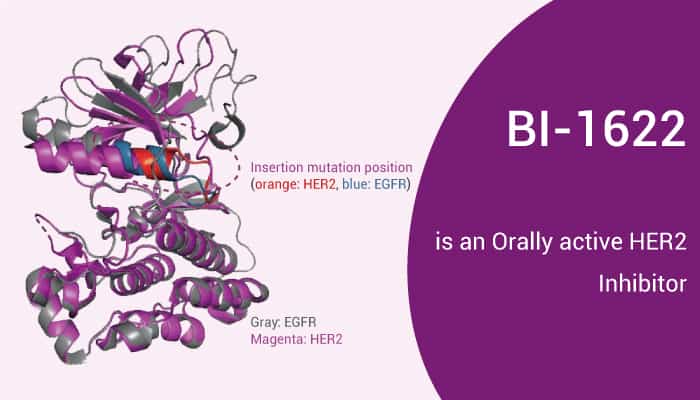BI-1622 is an orally active, potent, and highly selective HER2 (ERBB2) inhibitor, with IC50 values of 7.8, 7.1, <5.3 nM for HER2WT, HER2YVMA, EGFRWT, respectively. Besides, BI-1622 shows greater than 25-fold selectivity over EGFR. Moreover, BI-1622 shows high antitumor efficacy in vivo in xenograft mouse tumor models.
HER2 is a member of the human epidermal growth factor receptor (HER/EGFR/ERBB) family. But contrary to another member of the ERBB family, HER2 does not directly bind ligands. Notably, no ligands for HER2 have yet been identified. Furthermore, HER2 can heterodimerize with any of the other three receptors and is considered to be the preferred dimerization partner of the other ErbB receptors.
BI-1622 shows antiproliferative activity with IC50 values of 5, 48, 1010, and 23 nM for HER2YVMA, HER2YVMA, S783C, EGFRWT, EGFRC775S in Ba/F3 cells, respectively. In addition, BI-1622 (0-5 µM, 72 h or 96 h) inhibits the proliferation of HER2-dependent cell lines. Other more, BI-1622 induces a dose-dependent decrease in pHER2 and pERK levels in NCI-H2170 HER2YVMA and PC-9 HER2YVMA cells with an accompanying decrease in DUSP6 messenger RNA levels. Furthermore, This compound displays good permeability and no PgP-mediated efflux liability. Additionally, BI-1622 shows well in vitro clearance in mouse liver microsomes and mouse hepatocytes.
BI-1622 shows anti-tumor activity in vivo.

BI-1622 (1 mg/kg, i.v.; 10, 100 mg/kg, p.o.) shows moderate clearance, a moderate volume of distribution, and good to moderate bioavailability. Additionally, BI-1622 (0-100 mg/kg, orally, twice daily) inhibits tumor growth with a TGI of 73%. It inhibits oncogenic signaling in vivo.
In a word, BI-1622 is an orally active, potent, and highly selective HER2 inhibitor. Besides, BI-1622 inhibits HER2 exon 20 mutants while sparing WT EGFR. Moreover, BI-1622 shows antiproliferative activity and induces a dose-dependent decrease in pHER2 and pERK levels. Additionally, BI-1622 shows anti-tumor activity.
Reference:
[1] Wilding B, et al. Nat Cancer. 2022 Jul;3(7):821-836.